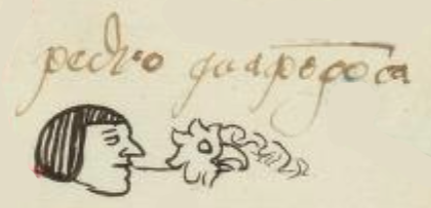Cuapopoca (MH814v)
This black-line drawing of the compound glyph for the personal name Cuapopoca (perhaps “The Eagle Smokes”) is attested here as a man’s name. The glyph shows the head of an eagle (cuauhtli) in profile, facing toward the viewer’s right. Curling lines that apparently represent smoke (and the verb to smoke, popoca) emerge from the top of the eagle’s head (cuaitl), rolling out downward and to the right.
Stephanie Wood
The name could be Cuauhpopoca (“The Eagle Smokes”), but the gloss gives Cuapopoca. This Cua- start to the name is reminiscent of other examples where Cuauh- might be expected. Frances Karttunen writes in response to a question about why Cuauhtemoc is often written Cuatemoc: “The digraph hu- (syllable-initially) and -uh (syllable finally) represents /w/. In syllable-final position, this is devoiced and ‘whispery.’” [Source: Association of Nahuatl Scholars, Facebook, August 12, 2024.] So, Cuapopoca is likely not intending “The Head Smokes” despite the Cua- (relating to the head) start to the name. It is interesting that the smoke curls do come from the head of the eagle. The reasoning may be that the tlacuilo wished to distinguish them from speech scrolls, which would instead come from the beak.
Stephanie Wood
1560
Jeff Haskett-Wood
águilas, humo, animales, pájaros, nombres de hombres

cuauh(tli), eagle, https://nahuatl.wired-humanities.org/content/cuauhtli
cua(itl), head, https://nahuatl.wired-humanities.org/content/cuaitl
popoca, to smoke, https://nahuatl.wired-humanities.org/content/popoca
El Águila Humea
Stephanie Wood
Matrícula de Huexotzinco, folio 814v, World Digital Library, https://www.loc.gov/resource/gdcwdl.wdl_15282/?sp=703&st=image.
This manuscript is hosted by the Library of Congress and the World Digital Library; used here with the Creative Commons, “Attribution-NonCommercial-ShareAlike 3.0 License” (CC-BY-NC-SAq 3.0).



